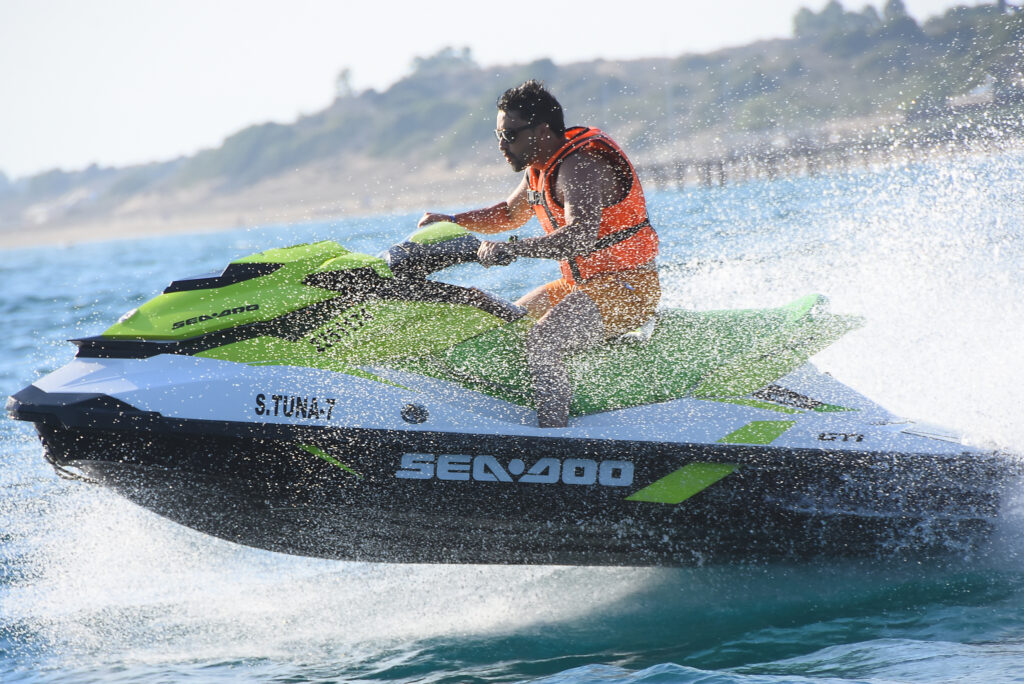Jet skis are agile and light, yet powerful and speedy – what are they made of?
Today, most production jet skis are primarily made from lightweight fiberglass and plastic, but some top-tier models are built from carbon fiber. However, the first jet ski models were originally made of aluminum.

Read on to learn more about jet skis, how they’re built, and how durable they are.
Light And Power
When Clayton Jacobson II created the first prototype jet ski way back in the sixties, he envisioned an agile craft built from aluminum. He was a daredevil and a thrill-seeker, and had plans for a powerful ‘motorcycle on the water’.
It would become his life mission to make his vision a reality, and he left behind a lucrative career in finance to pursue it. Although his first true build was primitive, it would lay the groundwork for the jet skis of today.
His original model was built from aluminum and was driven by a small two-stroke engine affixed to a jet water pump. His engineering prowess was picked up by a snow-mobile manufacturer who used their power to further his vision in earnest.
Working hand-in-hand with Bombardier, the manufacturer, Clayton Jacobson II designed a dozen prototypes before he transitioned into a ‘sit-on’ variant. Ultimately, he’d enter into a lucrative agreement with Kawasaki, who would reveal the world’s first production Jet Ski in 1973.
Times have certainly changed since those early aluminum builds, with most of today’s personal watercraft being built from fiberglass or carbon fiber. The technical term is ‘fiber-reinforced plastic’, with the plastic itself being intertwined with other fibers for added strength.
Although fiberglass is extremely workable and light, it is slightly brittle, and this causes obvious issues where jet skis are concerned. If they collide with rocks, docks, or other jet skis, they’re extremely susceptible to cracking or smashing.
However, there are very few materials that boast the attributes of fiberglass – it’s strong, smooth, light, and easy to maintain. If it gets scratched or chipped, it can often be repaired with ‘over-the-counter’ solutions.
The only material that beats out fiberglass in attribute quality is carbon fiber, the relatively modern material invented in 1958. It’s stronger than fiberglass, especially when paired with the right treatments, it’s lightweight and resistant to high temperatures and chemicals.
Carbon Is The Key
The use of carbon fiber in personal watercraft production is a relatively new practice. There were no real production carbon fiber jet skis until around 2011, with certain limited edition runs being released.
For example, there’s the Black Marlin ‘luxury’ jet ski, a vessel built almost entirely from carbon fiber. It boasts a weight saving of around ten kilograms when compared to traditional jet skis, yet it retains the durability and performance.
It also exuded aggressiveness, with a sleek design that was guaranteed to turn heads on the water. However, the state-of-the-art build, unfortunately, pushed the asking price to sixty-two thousand dollars, making it one of the most expensive jet skis in history.
That’s not the most extreme example, though. In 2011, a concept vessel was introduced, called the Exoconcept EXO, an all-electric, all carbon fiber personal watercraft.
Reportedly, the EXO was bizarre, being dramatically smaller than a standard jet ski, having very few controls, and requiring the user to lay flat to ride it. However, it had a minute CO2 footprint and was one-hundred percent recyclable.
Admittedly, the EXO did come with a string of benefits: it was so light it could be carried by two people, it released no emissions, and it registered a zero on the noise scale. Unfortunately, the company’s website no longer exists and there’s no information to explain what happened to them.
If It Ain’t Broke
Traditionally, almost all production personal watercraft on the market today will be made from fiberglass. Whether you’re buying a Sea-Doo, Yamaha, or Kawasaki, they’ll mostly be built from the exact same materials.
You can spend a few thousand dollars on an entry-level model, or twenty-thousand on a full-spec example; it’s all ultimately the same. They’re all subject to the same maintenance and repair requirements, including treating the hull against weather and water impact.
Fiberglass is also used in aircraft construction, boats, and even roofing or bathtubs. It can be used to line glass bottles, to build waterslides and hot tubs, or in circuitry.
It’s a versatile and diverse material that exists in many more places than you might think.
